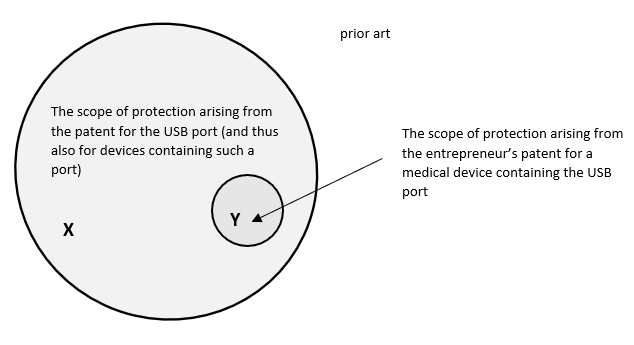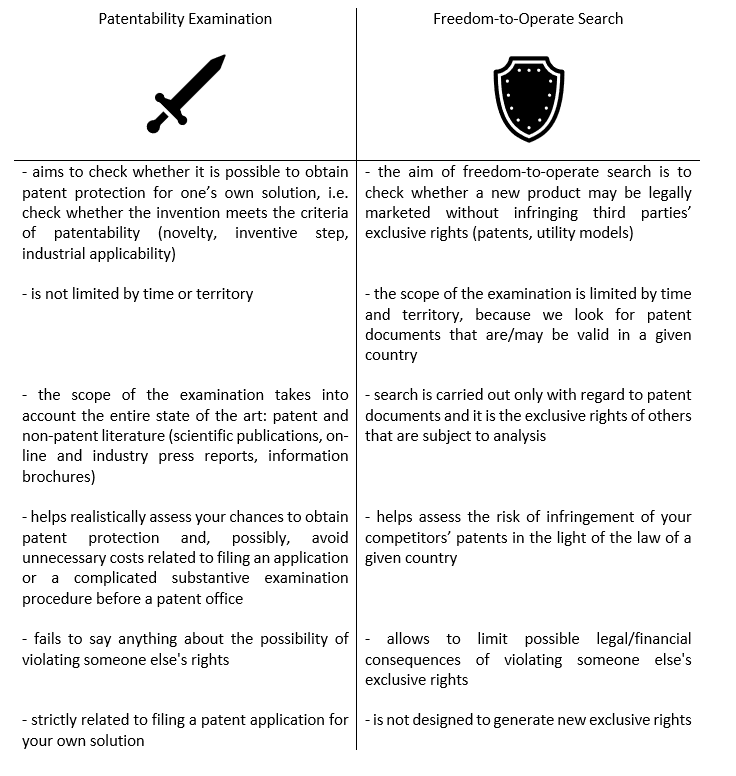Everyone is well aware of the significance of information and data as a resource nowadays. The same applies to the knowledge about a patent environment of the ideas or products we intend to put on the market. It is a valuable resource which is often vital to an entrepreneur’s financial success.
To acquire this valuable knowledge, patent examinations are carried out. Their aim is to find publications describing the most similar solutions to ours, formulate conclusions and respond to specific questions posed by the entrepreneur. The key thing is the ability to select the right type of examination depending on our needs, while taking into account the desired result of the search.
There are many types of patent examinations, but two of them are the most significant. These are a patentability examination and Freedom-To-Operate search and it is crucial to be able to distinguish between them.
“Able” inventions
A patentability examination seeks to determine the closest prior art and then assess the prerequisites of patentability in the light of the documents found. Prior art is considered to be everything that has been published so far in scientific literature, patent documents, commercial and technological brochures, or on the Internet. Therefore, the scope of such an examination is not limited by time or territory. The aforementioned prerequisites of patentability include a novelty of the solution on a global scale; an inventive step, i.e. its non-obviousness to a person skilled in the art; and industrial applicability understood, among others, as the possibility to manufacture an invention with a repeatable result as part of industrial activity. Such an examination aims to verify whether it is possible to obtain patent protection for your own solution, which should be a starting point for offensive actions aimed at obtaining a market monopoly. For example, if, in the course of the examination, we find a Chinese patent disclosing the same solution as the examined one, it means that the developed solution is not novel, meaning that it fails to meet one of the prerequisites of patentability. Similarly, the discovery of several publications related to a similar subject may lead the person skilled in the art to conclude that the newly developed invention is in fact an obvious combination of information from patent document “A” with teachings from scientific publication “B.” As a result, a patentability examination conducted before filing an application helps you realistically assess your chances of obtaining patent protection and may prevent you from incurring unnecessary costs related to filing procedures in a situation where a patent office expert carrying out a substantive examination of your application is likely to raise objections as to its patentability. On the basis of the knowledge of the closest state of the art and the patentability analysis conducted for the solution, a patent attorney will be able to correctly formulate patent claims (their preamble and characterizing part), as well as focus, in the description of the invention, on the technical problem solved by the invention which has not yet been effectively addressed by other similar solutions. Moreover, a diligent patentability examination may help you win over an investor or acquire grants. When conclusions in the examination report confirm the potential of the invention, it can be used as a tool in business negotiations.
“Clear” solutions
In contrast to a patentability examination of one’s own solution, a Freedom-to-Operate (FTO) search (or clearance search) does not focus on the assessment of the solution developed by the entrepreneur, but mostly on similar solutions whose patent protection is ongoing or may be afforded following patent grant for the patent applications already filed. The purpose of FTO search is to check whether a new product may be legally marketed, without infringing third parties’ exclusive IP rights, which means that it is strictly defensive in character. Therefore, such a search should always be carried out each time before the product is offered and sold on a given market, i.e. in relation to specific countries/territories. The difference with a patentability examination worth emphasizing is that an FTO search is always limited in time (up to 20 years back, as this is how long patent protection lasts, counting from the filing date, and this period can be extended by up to 5 years only for medicines and plant protection products following the grant of a supplementary protection certificate (SPC)) and to the designated territory where the entrepreneur plans to put the product on the market. After finding relevant patent documents in prior art, it is crucial to determine their legal status (whether they are still in force) and to analyse the scope of the protection granted, which arises directly from the content of patent claims. This helps assess the risk of infringement of competitors’ patents in the light of the law of a given country. Undoubtedly, an advantage gained by commissioning an FTO search is that you can limit possible legal and financial consequences of violating someone else’s exclusive rights. In addition, an FTO search report confirming freedom to operate in a given territory is a strong bargaining chip during talks with investors about the commercialization potential of your solution.
Attack and defend yourself using information from patent examinations
In conclusion, even if you gain a broad monopoly in the form of a patent for your own innovative solution, this does not mean that third parties’ exclusive rights (patents, utility models) are not infringed. For example, let us imagine that an entrepreneur has constructed a small medical device designed to measure a blood level of a selected biomarker at fixed intervals and store recorded data in its internal storage. Such a device includes a USB port for communicating with a computer and charging a battery. Although the designed device has met the prerequisites of patentability and the entrepreneur has obtained a patent for it, using it as part of professional and profit-making activities will infringe a patent for a USB port held by Intel. This is better illustrated by the drawing below with the use of the following sets:

Therefore, for the entrepreneur’s solution, there is no FTO. In the Y area, both the entrepreneur and the patent holder for the USB port block each other, as their scopes of market exclusivity overlap.
An example from another industry is a developed pharmaceutical or cosmetic composition which can be afforded patent protection and a resultant market monopoly if the composition is novel, non-obvious and industrially applicable. However, should one of its ingredients (a chemical compound) be protected by a patent held by another entity (and it is worth adding that the protection of inventions from the “product” category has the widest scope), the composition cannot be placed on the market without infringing someone else’s patent. Therefore, patentability is not equivalent with FTO for the solution.
The discussed patent examinations can certainly help optimize the process of developing and marketing new products. This type of patent analyses is best entrusted to patent attorneys, who, on the one hand, know the industrial property law regulations in force in a given country and, on the other hand, often have access to commercial patent databases that allow for a reliable search in the state of the art. It is worth commissioning such analyses to make sure that your company is more efficient in applying for patents (patentability examination) and to limit the possibility of being sued by third parties for the infringement of their patents (FTO search).

The article was published on February 11, 2022, in LIFE SCIENCE quarterly.
Author: Adam Trawczyński



